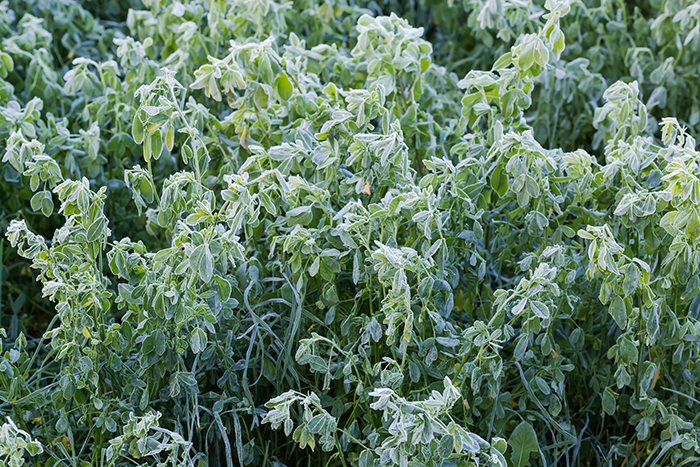What to do when frost bites |
| By Amber Friedrichsen, Managing Editor |
|
|
 The thin layer of frost that covered my windshield one morning last week was a subtle reminder of the harsh reality that colder weather is on the horizon. I’ve since located my ice scraper in the depths of my coat closet and promoted it to full-time shotgun rider. As frost starts to appear across the top tier of the United States, extra precautions must be taken for fall grazing and late-season forage harvesting. In a recent article from North Dakota State University, James Rogers reminds farmers of forage disorders like prussic acid poisoning, nitrate toxicity, and bloat that can occur when plants are stressed by a frost. “The most concerning of these frost effects is prussic acid, which can develop in the sorghum family of plants,” says the forage crops production specialist. “If cattle are grazing sorghum forages and frost warnings are in the forecast, remove cattle until after a killing frost has completely killed the plant and residual growth has fully dried down.” This may take a week or more, depending on weather conditions. If a frost occurs, but not a killing frost, wait for prussic acid to dissipate before letting cattle graze. Although plants may stop growing, the plant crown will still be active, and new shoots can emerge. Cattle should not graze new growth until plants are 18 to 24 inches tall, but at this point in the growing season, it may be just as well to retire the pasture until next year. Cutting affected forage for hay has previously been considered a viable option to mitigate prussic acid poisoning; however, more recent studies have shown dhurrin — the compound that is converted into prussic acid when forage is stressed — remains stable in hay after dry down. Chopping and ensiling sorghum forage is a safer way to release prussic acid before storing and feeding. Other ailments Nitrate toxicity can occur in a wider range of forage crops after a frost, including cereal grains, brassicas, sorghums, and millets. The environmental stress slows the processes that convert nitrates accumulated from the soil into plant-available forms. Livestock absorb excess nitrates in the bloodstream, which prevents oxygen transport and can lead to death. Similar to forage that is high in prussic acid, drying forage for hay will not reduce high nitrate levels, but ensiling can, to an extent. With that said, ensiled feed must be tested for nitrates at feedout. Another concern of frosted forage is a greater risk of bloat, especially in legumes. Bloat occurs when ruptured plant cells expel soluble proteins into the rumen, creating a buildup of froth. This prevents cattle from releasing gas and puts pressure on their internal organs. Frost damage can also raise potassium, calcium, and magnesium concentrations in plant cells, which elevates bloat risk as well. Rogers provides the following suggestions to mitigate each forage disorder after a frost occurs. Prussic acid • Wait seven to 10 days after a light frost to graze cattle on sorghum forages. • After a killing frost, wait to graze cattle until forage is completely dry. • Do not graze forage regrowth until plants are 18 to 24 inches tall, or until new plants experience a killing frost. • Avoid turning hungry cattle out on frosted sorghum forages. Nitrate toxicity • Test forage nitrate levels before grazing or feeding hay. • Dilute high-nitrate forage with low-nitrate forage. • Monitor livestock during grazing and/or feeding. • Ensure nitrate levels in stock water do not exacerbate animal health risks. Bloat • Avoid grazing alfalfa for at least three days. Other legumes may require up to five days to reduce bloat risk. • After a killing frost, let plants dry down completely before grazing. • Do not turn hungry cattle out on a pasture with a high percentage of legumes. • Provide animals supplementation like poloxalene blocks. • Monitor the entire herd. Some individuals are more prone to bloat than others. • If bloat occurs, be prepared to treat animals quickly. |
